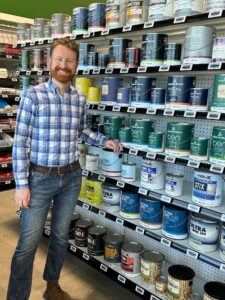
The ROI of Technology
Ready or not, technology is the future of the retail industry, and it’s here to stay. The pandemic permanently changed the retail landscape and how consumers shop and engage with businesses, placing an additional focus on technology. While not every operation needs to adopt the latest and greatest innovations, retailers should consider how technology can improve different areas of their operations and take a close look at the return on investment (ROI) for any type of technology. As you evaluate current and future tech options for your operation, discover best practices from experts and fellow retailers on how to measure ROI and the benefits technology brings to an operation.
Key Takeaways
- Look beyond traditional ROI metrics like time and money spent
- Choose innovations that align with your values and goals
- Focus on creating or improving efficiencies
“When analyzing ROI, it’s not so much about coming up with a specific number but understanding what you are going to spend and the benefits you’re going to get from that investment. It’s less about the ROI numbers and more about what you are trying to accomplish as a retailer.”
- Rebecca Wettemann
CEO and Principal at Valoir
Beyond the Numbers
Typically, when measuring ROI, you take the amount of money you earned, subtract the amount you invested and divide that number by the amount invested. But that formula doesn’t translate to all types of technologies or take into account factors beyond money. When it comes to evaluating technology, retailers should consider other aspects—efficiency gains, time saved, customer engagement, brand awareness and others—to determine whether the technology is successful or not.
 Rebecca Wettemann, CEO and principal of Valoir, a technology research firm, says retailers should look beyond traditional ROI formulas and key performance indicators (KPIs) specific to a technology.
Rebecca Wettemann, CEO and principal of Valoir, a technology research firm, says retailers should look beyond traditional ROI formulas and key performance indicators (KPIs) specific to a technology.
“When analyzing ROI, it’s not so much about coming up with a specific number but understanding what you are going to spend and the benefits you’re going to get from that investment,” Wettemann says. “It’s less about the ROI numbers and more about what you are trying to accomplish as a retailer.”
Two key factors to consider are reach and frequency, Wettemann says. Reach refers to the number of people, applications or processes a technology touches, with more touches equaling greater return. The more frequently a technology is used, or the more it can be applied across an operation, the greater the ROI.
“If I’m filling a bathtub, it’s a lot faster with a bucket than a measuring cup,” Wettemann says. “Look at how many people and processes you are impacting with a technology—that’s where you can see a true measure of its impact.”
With so many different ways to measure success, it may feel overwhelming or not worth your time, but Wettemann says taking stock of a technology’s impact is crucial. Retailers, especially small business owners, have many choices on where to invest money and need to be savvy about where that money goes.
“Retailers should look at technology investments the same way they’d look at other business investments, such as enhancing a storefront or hiring more workers,” Wettemann says. “When you look at the ROI of technology, you’re making sure you’re getting the most value for what you’re investing in your business.”
This mindset is especially important for small businesses that need to account for every dime spent. Wettemann suggests any business operator to take a close look at what a specific investment could yield in another area of the business.
For example, instead of spending it on a new technology, consider whether that money could offer a better ROI earning money in a high-yield savings account or invested in physical
store improvements.
“Business owners should take into account the payback time of any investment as well,” she says. “They need to look at how many months or years it will take to recoup the initial investment. The faster you can recoup an investment the better the ROI because you can then invest that capital elsewhere.”
Moving the Mission Forward
Technology plays a large role in Heuser Ace Hardware’s successes over the years. A key driver in the company’s technology investments, Bobby Heuser looks beyond traditional ROI when measuring a technology’s success. Heuser owns the operation—which includes three hardware stores and one paint store in the Hilton Head area of South Carolina—with his parents, Renee and Bob. The Heuser family has implemented a wide range of technologies since opening in 2015.
Heuser says while measuring traditional ROI is important, there are other factors a retailer should consider when evaluating success. The operation added electronic shelf labels (ESLs) to the Pawleys Island store in April 2022, the Hardeeville store in September 2022 and the Bluffton store in March 2023. Heuser looked beyond the cost and the payback period and took into account secondary benefits like improving efficiency and customer service to measure the success of the new technology.
 One such metric Heuser assesses is employee efficiency and time spent with customers. Many of the store’s employees are retired trade workers with specific skills in electrical, plumbing and construction that are critical for helping customers. Instead of putting 30 hours a week into price changes, thanks to the ESLs, employees use the same 30 hours a week to help customers, a positive ROI on employees’ time.
One such metric Heuser assesses is employee efficiency and time spent with customers. Many of the store’s employees are retired trade workers with specific skills in electrical, plumbing and construction that are critical for helping customers. Instead of putting 30 hours a week into price changes, thanks to the ESLs, employees use the same 30 hours a week to help customers, a positive ROI on employees’ time.
“We also found that digital price tags increase accuracy in our stores—the price on the shelf is always the price at the front,” Heuser says. “The tags decrease frustration and give the customer more information about the product, providing another touchpoint and a higher level of customer service.”
For Heuser, technology is successful for the operation if it aligns with and reinforces the operation’s mission statement. At one point, the Heusers considered adding self checkout but decided against it for the time being because they felt it wouldn’t advance their mission and goals.
“We try to be the most helpful company in our town and want to introduce technologies that reinforce that value proposition,” Heuser says. “Just because it’s a positive ROI on paper, doesn’t necessarily mean it’s going to be an overall positive for your company or customers. It has to line up with your mission.”
Expanding Your Reach
ROI can also come in the form of more customers or a new customer base, as is the case with Pintura Paint in San Antonio, Texas. Since taking over the business in 2019, managing partner Danny Garcia has focused on using marketing—specifically digital communications— to boost sales and connect with customers.
 One of his first tasks was creating a Facebook page for the store, where he posts five to seven times a week using Hootsuite to manage and schedule posts. Posts include videos of new products, the store and special events promotions. His children, 8-year-old Arianna Garcia and 4-year-old Polo Garcia, also make frequent appearances on the social feed to the delight of many customers.
One of his first tasks was creating a Facebook page for the store, where he posts five to seven times a week using Hootsuite to manage and schedule posts. Posts include videos of new products, the store and special events promotions. His children, 8-year-old Arianna Garcia and 4-year-old Polo Garcia, also make frequent appearances on the social feed to the delight of many customers.
“Establishing a digital presence was the biggest challenge when we took over,” Garcia says. “The previous owners didn’t have a good foothold on any social media platforms or an online presence, so I took that challenge on and it has really paid off.”
The emphasis on building their digital presence has led to new customers coming in every week. Garcia says he frequently asks new customers how they found out about the store, and if they say online, he asks where specifically.
“I want to know if they found us on Google, Facebook, Pinterest or somewhere else online,” he says. “While a lot of people don’t remember specifically, those metrics help me better gauge where our marketing is working.”
For his operation, Garcia says technology looks different than it might for a hardware retailer or even another paint operation. But no matter what your technology looks like, it’s still important to assess what’s working and what’s not and come up with ways to measure success, whether that’s measurable data or anecdotal stories.
“In the paint world, technology just looks different,” Garcia says. “But it is important to evaluate what you’re doing and if it’s working and make adjustments as needed.”
